HOME > Kanazawa Utatsuyama Kogei Kobo
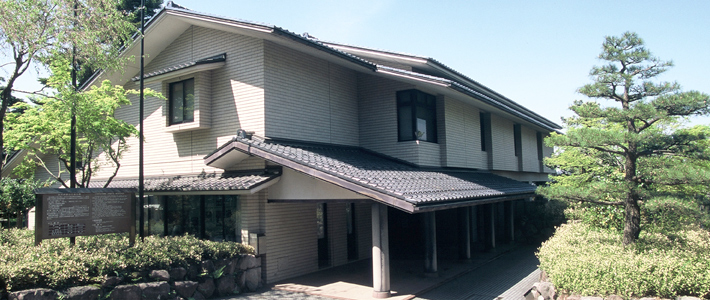
The Kanazawa Utatsuyama Kogei Kobo was established on November 1, 1989 in commemoration of the 100th anniversary of the founding of the city of Kanazawa. The kobo (workshop) is as an institution that specializes in KOGEI (crafts), and is responsible for the preservation and development of KOGEI in Kanazawa as well as the promotion of cultural activities. Kanazawa is known for its tradition of excellence in KOGEI, which developed from the activities of the Osaikusho (Kaga Clan Kobo). To retain the spirit of its forerunners, the Kobo adhered to three principles: "To train artists who will work actively at the international level," "To exhibit KOGEI to the public," and "To encourage the public to participate in KOGEI." Through exhibitions and workshops for the public, it strove to continue to develop the culture of KOGEI. Since 1989, the kobo has offered traineeships to artists and has cultivated trainees to have the creativity to use their art to respond to the changing times.
30 years after its foundation, the kobo was renovated and re-opened on November 1, 2019 in commemoration of the 130th anniversary of the founding of Kanazawa City. The three principles of the kobo were also updated to reflect its changing nature. These renewed principles include: "To train artists who will work actively at the international level," "To connect with the world proactively," and "To diffuse authentic KOGEI (crafts) all over the world." The Kobo aims to be a focal point for producing world-class craftspeople who play active roles in KOGEI while also adjusting to the changing times. We connect and exchange with artists all over the world through Kanazawa's sister city partnerships and the UNESCO Creative City of Crafts and Folk Art network. We also hand down Kanazawa's KOGEI to future generations and spread authentic KOGEI art.
We enhance our creative environment to train world-class craftspeople.
We produce craftspeople who contribute to the promotion of crafts while acquiring high-level skills and outstanding formative senses through activities that still allow for artistic freedom.
We interact with the world's communities through the networks of sister cities and creative cities.
We accept artists from sister cities and creative cities to enhance the sensibilities and techniques of world-class crafts, and to provide trainees with opportunities to improve their skills and insights.
We spread authentic crafts to the world, and invite outstanding artists, skills and cutting-edge materials and information.
We integrate new technology with traditional skills, while retaining the spirit of Osaikusho (Kaga Clan Kobo).
Ceramics Studio
Here, trainees create ceramic ware on the site of the former Kasugayama kiln, where "revived" Kutani ware was initially fired. Trainees are exploring new possibilities for designing art made from clay materials, while contemplating their relationship with society as creators.
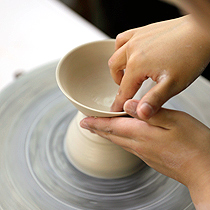
Urushi Work Studio
Kanazawa's lacquerware features Kaga maki-e decoration, a technique that was learned from Igarashi Doho, a master of makie in Kyoto during the Momoyama Period (1573-1603). While learning traditional techniques, students incorporate new techniques and designs to create new works with a modern sense of beauty.
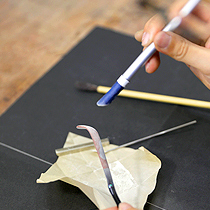
Dyeing Studio
Kanazawa's dyeing technique, derived from the traditional Kaga method, has been passed down to the present as Kaga Yuzen dyeing, and has greatly influenced the art of dyeing. Trainees learn the history of Kanazawa's dyeing, and master traditional dyeing techniques such as Yuzen dyeing, pattern embossing, squeezed dyeing and wax dyeing. They aim to expand the possibilities of modern dyeing using a variety of dyeing methods.
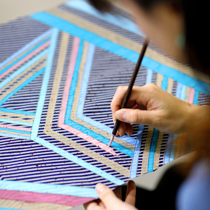
Metalwork Studio
We train artists to create new works using metalwork techniques such as metalcarving, hammering, and Kaga inlay, which originated in Kanazawa in the early Edo Period. Trainees make their own tools, and are trained in technique, creating forms and design. We encourage them to create original works, and to expand their vision in order to play an active role both in Japan and overseas.
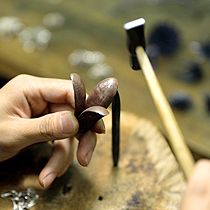
Glass Studio
Glass art was introduced to add a newer art form to craft techniques that originated in the Edo Period. A variety of glass techniques such as hot work, cold work, lampwork and kiln work are used to create new glass art that reflects the inspiration of our trainees.
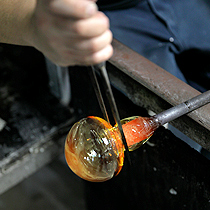
Resource Room I is located on the 1st floor of the main building. There, we exhibit contemporary KOGEI (crafts) works, such as our current and previous trainees' works, as well as the works of our faculty members. Resource Room II is located on the 2nd floor of the main building. There, we collect historical KOGEI works and resources from the Osaikusho (Kaga Clan Kobo), and KOGEI works made from ceramics, urushi (lacquer) work, dyeing, and metalwork in Kanazawa.


Tuesdays.
Train: Get off at Kanazawa JR station
Bus: Take bus no. 90 from Kanazawa Station, get off at Bokodai, and walk for about 7 min.
Taxi: A 10-min. ride from Kanazawa JR Station
Car: About 15 min. from Kanazawa Higashi IC on the Hokuriku Highway
Kanazawa Utatsuyama Kogei Kobo
To-10 Utatsumachi, Kanazawa, Ishikawa 920-0832
![]()
〒920-0832 石川県金沢市卯辰町ト10 TEL:076-251-7286 FAX:076-251-9113
Copyright © Kanazawa Utatsuyama Kogei Kobo. All Rights Reserved.